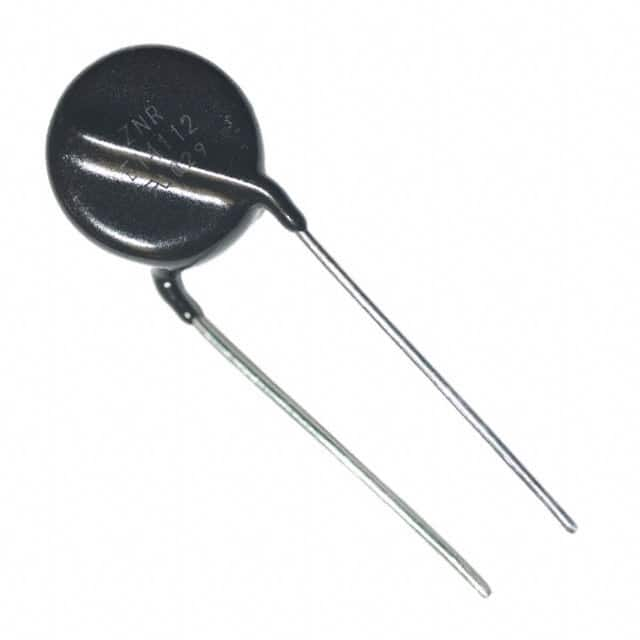Viz Specifikace pro podrobnosti o produktu.

ERZ-E10F471 Product Overview
Introduction
The ERZ-E10F471 belongs to the category of electronic components and is commonly used for surge protection in various electrical and electronic systems. This entry provides a comprehensive overview of the ERZ-E10F471, including its basic information, specifications, detailed pin configuration, functional features, advantages and disadvantages, working principles, application field plans, and alternative models.
Basic Information Overview
- Category: Surge Protection Component
- Use: Protecting electrical and electronic systems from voltage surges
- Characteristics: High surge current capability, fast response time, compact design
- Package: Encapsulated in a protective housing
- Essence: Zinc oxide varistor
- Packaging/Quantity: Typically available in bulk packaging
Specifications
- Model: ERZ-E10F471
- Maximum Allowable Voltage: 470V
- Nominal Diameter: 10mm
- Peak Current Capability: 6000A
- Operating Temperature Range: -40°C to 85°C
- Insulation Resistance: ≥100MΩ
Detailed Pin Configuration
The ERZ-E10F471 typically consists of two leads for connection to the circuit. The pin configuration may vary based on the specific manufacturer's design, but generally follows a standard layout with clear markings for identification.
Functional Features
- Surge Protection: Provides effective protection against voltage surges and transients.
- Fast Response Time: Rapidly clamps excessive voltage to protect downstream components.
- Reliability: Designed for long-term and reliable operation in diverse applications.
Advantages and Disadvantages
Advantages
- High surge current capability
- Fast response time
- Compact design
- Reliable surge protection
Disadvantages
- Limited maximum allowable voltage
- Requires periodic testing and replacement in high-stress environments
Working Principles
The ERZ-E10F471 operates based on the principle of zinc oxide varistors, which exhibit a non-linear voltage-current characteristic. When subjected to a surge or transient voltage, the varistor rapidly changes its impedance to divert excess current away from the protected circuit, thereby safeguarding connected equipment.
Detailed Application Field Plans
The ERZ-E10F471 finds extensive use in various applications, including: - Power distribution systems - Telecommunication equipment - Industrial control systems - Consumer electronics - Renewable energy installations
Detailed and Complete Alternative Models
Several alternative models to the ERZ-E10F471 include: - ERZ-E10D431 - ERZ-E14D471 - ERZ-V10D471 - ERZ-V14D471 - ERZ-V20D471
In conclusion, the ERZ-E10F471 serves as a crucial component in protecting electrical and electronic systems from voltage surges, offering reliable surge protection, fast response time, and high surge current capability. Its compact design and functional features make it suitable for a wide range of applications across different industries.
Word Count: 443
Seznam 10 běžných otázek a odpovědí souvisejících s aplikací ERZ-E10F471 v technických řešeních
What is ERZ-E10F471?
- ERZ-E10F471 is a type of metal oxide varistor (MOV) that is commonly used for overvoltage protection in electronic circuits.
What are the key features of ERZ-E10F471?
- ERZ-E10F471 offers high surge current capability, fast response time, and low leakage current, making it suitable for protecting sensitive electronic components from voltage spikes.
What is the maximum voltage rating of ERZ-E10F471?
- The maximum voltage rating of ERZ-E10F471 is typically around 470V.
How does ERZ-E10F471 provide overvoltage protection?
- ERZ-E10F471 acts as a voltage clamping device, conducting excess current when the voltage exceeds its threshold, thereby diverting the surge away from the protected circuit.
What are the typical applications of ERZ-E10F471?
- ERZ-E10F471 is commonly used in power supplies, industrial equipment, telecommunications devices, and other electronic systems to protect against transient voltage events.
What is the operating temperature range of ERZ-E10F471?
- The operating temperature range of ERZ-E10F471 is usually between -40°C to 85°C, allowing for reliable performance in various environmental conditions.
How should ERZ-E10F471 be connected in a circuit?
- ERZ-E10F471 should be connected in parallel with the circuit or component to be protected, ensuring that it can shunt excess voltage away from the sensitive components.
What is the lifespan of ERZ-E10F471?
- The lifespan of ERZ-E10F471 is typically long, as long as it is not subjected to repeated overvoltage events beyond its specified ratings.
Can ERZ-E10F471 be used in automotive applications?
- Yes, ERZ-E10F471 can be used in automotive electronics to protect against voltage transients and surges.
Are there any special handling considerations for ERZ-E10F471?
- ERZ-E10F471 should be handled with care to avoid mechanical damage, and it should be stored in a dry and clean environment to maintain its performance characteristics.

